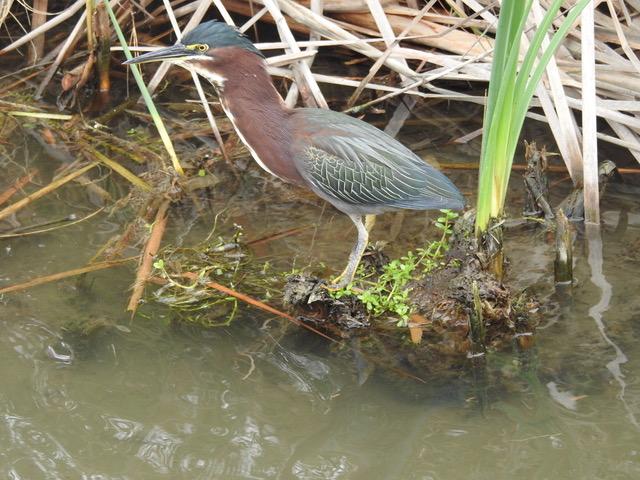Photos by Sandra Mink
Ah, a relaxing day of fishing! Buy some shrimp, bait your hook, cast, then sit on the jetties and wait—that is, if you are human.
If you’re a green heron—a stocky, crow-sized wading bird common to our wetlands—you may well fish with bait, too, dropping a twig, feather, bread crust, dried leaf or insect into the water, sometimes swishing it around a little, patiently awaiting the arrival of curious or hungry prey. In fact, this heron joins the vaunted ranks of crows, ravens and parrots as users of tools.
But, like all successful hunters, the green heron employs multiple strategies. In or near shallow water, it crouches, seemingly frozen, as it awaits prey—small fish, frogs, crustaceans and insects. It perches on low limbs or logs, diving into the water. Like a feline, it stalks its prey, stealthily placing one foot down, toes first, then another. It may walk quickly or rake the mud with its feet, presumably to stir up quarry. It grasps or spears prey with its dark, sharp bill.
This heron often appears hunched—reminiscent of a severe, grumpy human—since it presses its elongated neck against its body. A skilled fashion designer couldn’t replicate its appealing, subtly blended colors—with its back and sides a warm chestnut, its underparts green blended with bluish gray, its neck white, and its sometimes shaggily-crested crown bluish or greenish. Its legs, as well as its irises, are yellow or orange. Colors on males intensify during breeding season, when lores (spaces between bills and eyes) turn blue-black, and elongated dark plumes sprout from their heads. As it walks, a green heron may lift or depress its crest and flick its tail. A web between its outer and middle toes, as well as its oil gland and powder down—specialized feathers, the tips of which disintegrate into powder, which birds rake into their feathers—facilitate its swimming.
The blue heron (Butorides virescens) joins other herons, as well as egrets and bitterns, in the family Ardeidae, whose members have powder down and, unlike storks or ibises, fly with retracted, rather than outstretched necks. This heron’s genus name, Butorides, comes from the Middle English word butor, meaning “bittern”. Its species name, the Latin word virescens,means “greenish”.
This heron breeds in mainland Eastern and Midwestern states, including the eastern two-thirds of Texas, as well as a coastal strip of the Pacific Northwest. It migrates southwards in wintertime, but it lives year-round on the Gulf Coast. I see it often—on South Padre Island, at Pendleton Park in Harlingen, and along resacas. Content with both salt and freshwater, it prefers to dwell in woodlands or patches of trees or other vegetation, including the Island’s luxurious Island mangrove swamps.
Green herons are currently nesting in the Valley, including at the South Padre Island Birding, Nature Center and Alligator Sanctuary, which Javier Gonzalez, its Naturalist Educator, believes has about four nests, one which “has one week-old chicks already.” Though green herons are sensitive to nesting disruptions, Gonzalez said that “the birds are not really bothered by people, as they are used to the daily visitor traffic on the boardwalk.”
A male green heron advertises his availability with a call of “show-ch” or “ow-ch”, and he may give a “skow” call from the top of a tree. A female does the same with a “skoow” or “skyow”. “The male starts the nest,” Gonzalez said, looking “for the perfect sticks far and wide,” and “more often than not, snaps them off branches.” Gonzalez said the male “does a special call”, inviting females to do a nest inspection, and a female who likes it will stay “but remodel things a bit.” Then, he said, the male carries sticks to her to place in the nest, which may be from about eight to twelve inches in diameter.
Green herons prefer to nest in trees or shrubs overhanging shallow water, usually alone, but sometimes with those of their own or other species. A pair shares responsibility for defending the nest, incubating the three to five eggs and nurturing hatchlings. Intense heat kills eggs and nestlings, so parents must diligently shade both.
The semi-altricial (somewhat helpless) chicks are born, eyes open, with grayish brown down and white bellies. Hatchlings move their heads a little and soon begin a “tik-tik-tik-tik” call for food, which a parent regurgitates into their mouths. At about a week, chicks stubbornly grab their parents’ bills, prompting regurgitation. At about 15 days, they jump from nests to nearby branches, and at about three weeks, they take short flights. At 30 to 35 days, fledglings snag prey in the water and swim, but they remain in the mangroves or other settings for continued care.
Populations of green herons, while robust, have declined. Once shot and eaten, they are now protected by the Migratory Bird Treaty Act. These birds appreciate solitude, and they may abandon nests if humans, including well-meaning researchers, approach too closely. They must have wetlands, even fragmented ones. Green herons do flock to man-made reservoirs, as well as islands made of dredge materials.


